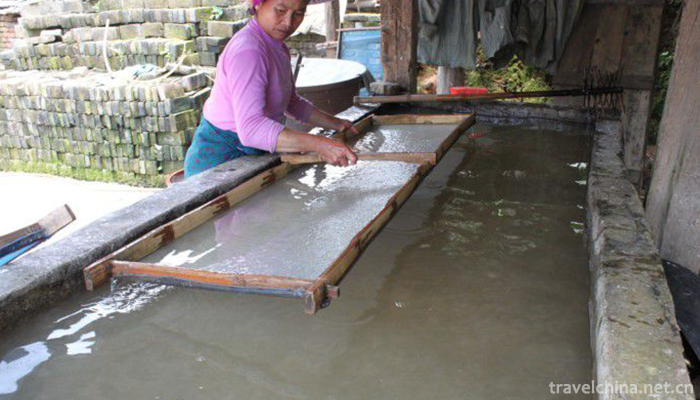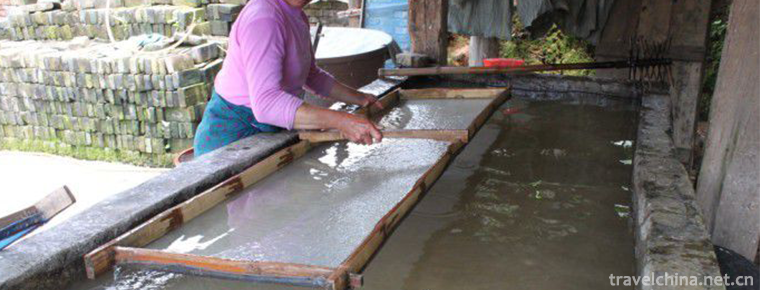Manufacturing Techniques of Tussah Paper
Manufacturing Techniques of Tussah Paper
The manufacturing history of tussah paper is as long as that of linen paper. The raw material for making the paper is the phloem fibers of the tree. The bark of the tree contains wood phloem fibers which are very suitable for papermaking.
On June 7, 2008, the paper was approved by the State Council to be included in the second batch of national intangible cultural heritage list.
Orion of the Name
Because of its long history and suitable for high-level painting and calligraphy, it has been paid special attention by literati. Sometimes the word "chu" becomes the symbol of paper. For example, Zhang Yi (1237-1368) wrote in his poem "Wood and Stone Pictures" for Zhao Mengfu, a contemporary Wuxing calligrapher and painter (1254-1322): "Wu Xing's brushwork is wonderful, and there are no people left behind. A piece of paper is a piece of paper. Xu Wei (1521-1593), a Ming Dynasty painter, said in"Painting Crane Fus": ink is like work, and life-long fun. Here the ink is paper ink, which means that if the ink and paper are made fine, it can be appreciated for a lifetime after being painted and calligraphed. Other scholars took it as their subject matter and personalized it into a funny biography.
Improvement
Technological improvement in the Ming Dynasty was a major stage of Chinese handmade paper. The manufacture of tussah paper was particularly prominent. It was produced in almost all parts of the country. It was suitable for various purposes. Its output, quality and processing technology reached an unprecedented high level.
During this period, there were also detailed documentation about the manufacture of paper. Dazhi of Jiangxi Province, edited by Wang Zongmu (1523-1591) of the Ming Dynasty in 1556? Chu Shu Chapter is the earliest work in the world to discuss in detail the manufacture of Chu Paper.
Dazhi of Jiangxi Province mainly records the technology of making paper in Yushan County, Guangxinfu Prefecture of Jiangxi Province (now Shangrao area) during Hongwu Period. According to Mr. Pan Jixing's research, the technological process of this kind of paper is as follows: immersing the material in water for several days, bundling it into small handles, boiling it in clean water, cutting the inner bones, pulling the bark into silk, cutting the bark into small bundles with knives or axes, soaking it with lime pulp, and storing it for the rest of the month, soaking it with lime pulp. Cooking in the pot taking the material out of the pot, rinsing the water naturally for several days in the cloth bag with river water treading to limewater pestle spread on the ground or hillside in the sun and rain, until color white using treadle or pestle mortar to make fine adding boboiled grass wood ash water on the pestle material to bubble, half a month dry river water washing material re-boiling water into the pot again into the boiling water to boiling in the pot again._Exposure to sunlight_Hand handling of secondary materials and miscellaneous materials Quality rejection fine chopping with knife, until crushed into pieces washed in the inner bag mixing with water into the tank adding paper to the tank salvaging paper pressing water drying of the fire wall uncovering paper from the wall trimming and packing. This method includes four times of cooking, including two times of fresh water cooking and two times of alkaline solution cooking. After this treatment, the paper is white as jade, the fibers are even and fine, and the surface is smooth, but it takes a lot of time and labor. The rulers never care about the cost of paper.
In addition to Jiangxi Dazhi, Huizhou Zhi (1502), edited by Peng Ze of Ming Dynasty, and Tiangong Kaiwu, edited by Song Yingxing, also have some technical records on paper, but they are relatively simple and less formalities.


-
1.Shennongjia Forestry DistrictHubei Shennongjia
Shennongjia Forest District, referred to as Shennongjia for short, was established in 1970 with the approval of the State Council and directly under the jurisdiction of Hubei Province.
Time 2018-10-28 -
2.south china botanical garden
The South China Botanical Garden of the Chinese Academy of Sciences, which belongs to the Chinese Academy of Sciences, is one of the most important botanical and ecological research institutions in Ch
Time 2018-12-26 -
3.Jingtai Yellow River Stone Forest
The Yellow River Stone Forest is located in the southeast of Jingtai County, Baiyin City, adjacent to Longwan Village, Zhongquan Township. It covers an area of about 10 square kilometers
Time 2019-01-29 -
4.Xishuangbanna Tropical Flower Garden
Xishuangbanna Tropical Flower Garden is located in Yunnan Institute of Tropical Crop Sciences, Jinghong City, Xishuangbanna Prefecture, Yunnan Province. It covers an area of 80 hectares and is one of
Time 2019-02-25 -
5.Lotus fall lian hua lao
Lotus Flower is a kind of traditional folk art with both rap and singing. The performers are mostly one person, self-talk and self-sing, self-play seven pieces of accompaniment.
Time 2019-05-13 -
6.Maonan Fat Cover
"Fat set" is the general name of Maonan people's vow-making activities. It prevailed in the Ming and Qing Dynasties. At the beginning, Maonan people used Nuo rituals to sacrifice the heavens
Time 2019-05-27 -
7.Naxi Remei Biao
"Remei Biao" is also known as "Wo Yo Ye", which is a collective folk custom that has been spreading for thousands of years. There are more than ten people at least and hundreds of
Time 2019-06-07 -
8.Shibao Mountain Song Club
The Bai Jianchuan Shibao Mountain Song Festival is held every year from 27 to 29 July of the lunar calendar for three days. At this time, tens of thousands of young Bai men and women and singers from
Time 2019-06-15 -
9.Production Techniques of Wufangzhai Zongzi
The traditional production techniques of Wufangzhai zongzi are mainly divided into 36 processes, such as material selection, rice dipping, leaf boiling, stuffing, shelling, wrapping, thread binding an
Time 2019-06-29 -
10.Small febrile coma
Xiao Redun is a kind of traditional Wu rhetoric banter popular in Jiangsu, Zhejiang and Shanghai. It is also known as "Xiaogongshu", commonly known as "selling pear ointment candy"
Time 2019-07-06 -
11.Du Fu
Du Fu (712 - 770 years), Zi Zi Mei, from the Shao Ling old man, Tang dynasty Great realistic poets, and Li Bai It is called "Li Bai". Originally from Xiangyang, Hubei, Henan county. With two
Time 2019-09-07 -
12.The origin of Chinese embroidery
Embroidery originated very early. The article on the embroidery of Fu Yu can be seen in Shangshu. In the time of Yu Shun, embroidery was already in use. In the Eastern Zhou Dynasty, there was an official in charge of it, and in the Han Dynasty, there was Royal embroidery
Time 2020-12-12